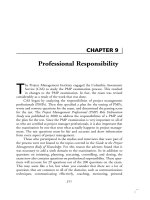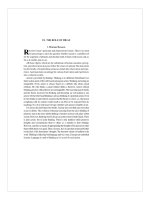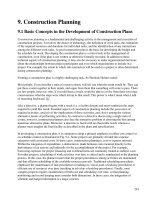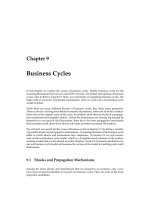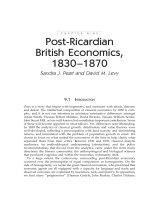Chapter 9 charismatic leadership
Bạn đang xem bản rút gọn của tài liệu. Xem và tải ngay bản đầy đủ của tài liệu tại đây (586.38 KB, 32 trang )
.c
om
an
co
ng
Chapter 9
cu
u
du
o
ng
th
Charismatic and
Transformational
Leadership
Copyright © 2010 by South-Western/Cengage Learning
All rights reserved.
CuuDuongThanCong.com
PowerPoint Presentation by Rhonda S. Palladi
Georgia State University
/>
.c
om
Charismatic and
Transformational Leaders
cu
u
du
o
ng
th
an
co
ng
Often have a more heightened sense of
who they are
Seem to have a clearer picture of their
personal meaning or purpose in life
sooner
Seek to actualize their personal meaning
through leadership
2
CuuDuongThanCong.com
/>
.c
om
Personal Meaning
du
o
ng
th
an
co
ng
Is the degree to which people’s lives
make emotional sense and to which the
demands confronted by them are
perceived as being worthy of energy and
commitment
Is the ―work–life balance‖
cu
u
The achievement of equilibrium in personal
and official life
3
CuuDuongThanCong.com
/>
.c
om
Factors That Influence
Personal Meaning
cu
u
du
o
ng
th
an
co
ng
Self-belief - knowing who you are based on your
lifespan of experiences
Legacy - allows an individual’s accomplishments to
―live on‖
Selflessness - unselfish regard for or devotion to the
welfare of others
Cultural heritage and traditions - done through rites
and ceremonies
Activist mind-set - a greater sensitivity to political,
societal situations that are ready for change
Faith and spirituality - rely on faith for support
Personal interests - pursuit of meaningful personal
pursuits
Values - values-based leadership
CuuDuongThanCong.com
/>
4
.c
om
Charismatic Leadership Linkages
cu
u
du
o
ng
th
an
co
ng
Personal meaning is linked to charismatic
leadership
The leader’s personal meaning influences his or
her behavior
The leader’s behavior is reflected in the
formulation and articulation of a vision
The leader’s vision garners attributions of
charisma from followers
Therefore, a primary aspect of charismatic
leadership involves the perceptions and
evaluations made by followers about a leader’s
behavior
CuuDuongThanCong.com
/>
5
.c
om
Charisma
cu
u
du
o
ng
th
an
co
ng
Is ―a distinct social relationship between
the leader and follower, in which the
leader presents a revolutionary idea, a
transcendent image or ideal which goes
beyond the immediate…or the
reasonable; while the follower accepts
this course of action not because of its
rational likelihood of success…but
because of an effective belief in the
extraordinary qualities of the leader‖
6
CuuDuongThanCong.com
/>
.c
om
Weber’s Conceptualization
of Charisma
cu
u
du
o
ng
th
an
co
ng
Weber used the term ―charisma‖ to
explain a form of influence based not on
traditional or legal–rational authority
systems but rather on follower
perceptions that a leader is endowed with
the gift of divine inspiration or
supernatural qualities
Charisma has been called ―a fire that
ignites followers’ energy and
commitment, producing results above
and beyond the call of duty‖
7
CuuDuongThanCong.com
/>
.c
om
Differentiating Between Charismatic and
Noncharismatic Leaders
co
ng
There are four behavior attributes that
distinguish charismatic from
noncharismatic leaders:
cu
u
du
o
ng
th
an
Dissatisfaction with status quo
Compelling nature of the vision
Use of unconventional strategies for
achieving desired change
A realistic assessment of resource needs and
other constraints for achieving desired
change
8
CuuDuongThanCong.com
/>
.c
om
Locus of Charismatic Leadership
an
co
ng
The question at the center of the debate
of Weber’s conceptualization of charisma
is whether charisma is primarily the
result of:
cu
u
du
o
ng
th
The situation or social climate facing the
leader
The leader’s extraordinary qualities
An interaction of the situation and the
leader’s qualities
– There is increasing acceptance of this view
9
CuuDuongThanCong.com
/>
.c
om
Effects of Charismatic Leadership
cu
u
du
o
ng
th
an
co
ng
Followers trust in ―rightness‖ of the
leader’s vision
Similarity of follower’s beliefs and values
to those of the leader
Heightened sense of self-confidence to
contribute to accomplishment of the
mission
Acceptance of higher or challenging goals
10
CuuDuongThanCong.com
/>
.c
om
Effects of Charismatic
Leadership (cont.)
cu
u
du
o
ng
th
an
co
ng
Identification with and emulation of
leader
Unconditional acceptance of leader
Strong affection for the leader
Emotional involvement of the follower in
the mission
Unquestioning loyalty and obedience to
the leader
Source: Based on R. J. House and M. L. Baetx (1979), “Leadership: Some Empirical Generalizations and New Research
Directions.” In B. M. Staw (ed.), Research in Organizational Behavior, vol. 1 (Greenwich, CT: JAI Press, 1979), 399–
401.
11
CuuDuongThanCong.com
/>
.c
om
Qualities of Charismatic Leaders
Superb
communication
skills
co
ng
Vision
Self-confidence
and moral
conviction
an
Ability to
inspire trust
ng
th
Qualities of
Charismatic
Leaders
High risk
orientation
Relational
power base
cu
u
du
o
High energy
and action
orientation
Minimum
internal
conflict
CuuDuongThanCong.com
Self-promoting
personality
Ability to
empower others
12
/>
.c
om
How One Acquires
Charismatic Qualities
co
ng
Suggested strategies for acquiring or
enhancing one’s charismatic qualities
include:
cu
u
du
o
ng
th
an
Developing your visionary skills through
practice and self-discipline
Practicing being candid
Developing a warm, positive, and humanistic
attitude toward people rather than a
negative, cool, and impersonal attitude
Developing an enthusiastic, optimistic, and
energetic personality
13
CuuDuongThanCong.com
/>
.c
om
Charisma: A Double-Edged Sword
cu
u
du
o
ng
th
an
co
ng
It is possible to assume that all
charismatic leaders are good moral
leaders that others should emulate
Remember that not all charismatic
leaders are necessarily good leaders
14
CuuDuongThanCong.com
/>
.c
om
Charisma:
A Double-Edged Sword (cont.)
th
Self-glorification
an
co
ng
One method of differentiating between
positive and negative charisma is to
consider the motives that are driving the
charismatic leader’s behavior:
u
du
o
ng
– Influences one’s meaning in life by protecting,
maintaining, and aggrandizing one’s self esteem
– Is consistent with negative (destructive) charisma
cu
Self-transcendence
– Provides meaning through supportive relationships
with others
– Is consistent with altruistic and empowering
15
orientations of positive (constructive) charisma
CuuDuongThanCong.com
/>
.c
om
Personalized Charismatic Leaders
du
o
ng
th
an
co
ng
Possess a dominant, Machiavellian, and
narcissistic personality
Pursue leader-driven goals and promote feelings
of obedience, dependency, and submission in
followers
Use rewards and punishment to manipulate and
control followers
Examples of personalized charismatic leaders:
u
Adolph Hitler
Charles Manson
David Koresh
Rev. James Jones
cu
16
CuuDuongThanCong.com
/>
.c
om
Socialized Charismatic Leaders
cu
u
du
o
ng
th
an
co
ng
Possess an egalitarian, self-transcendent, and
empowering personality
Pursue organization-driven goals and promote
feelings of empowerment, personal growth, and
equal participation in followers
Examples of socialized charismatic leaders:
Martin Luther King, Jr.
Gandhi
Winston Churchill
John F. Kennedy
President Obama
17
CuuDuongThanCong.com
/>
.c
om
Transformational Leadership vs.
Transactional Leadership
Transformational leadership
th
an
co
ng
Serves to change the status quo by
articulating to followers the problems in the
current system and a compelling vision of
what a new organization could be
ng
Transactional leadership
cu
u
du
o
Seeks to maintain stability within an
organization through regular economic and
social exchanges that achieve specific goals
for both the leaders and their followers
18
CuuDuongThanCong.com
/>
.c
om
Transformational vs.
Transactional Leadership (cont.)
cu
u
du
o
ng
th
an
co
ng
Despite these differences,
effective leaders exhibit both
transactional and transformational
leadership skills in appropriate
situations
19
CuuDuongThanCong.com
/>
.c
om
The Effects of
Transformational Leadership
cu
u
du
o
ng
th
an
co
ng
Research studies have consistently
revealed that transformational leadership
is positively related to individual level,
group, and organizational performance
20
CuuDuongThanCong.com
/>
.c
om
Charismatic versus
Transformational Leadership
cu
u
du
o
ng
th
an
co
ng
Charismatic leaders by nature are
transformational, but not all transformational
leaders achieve their transforming results
through the charismatic effects of their
personalities
Transformational leaders are similar to
charismatic leaders in that they can articulate a
compelling vision of the future and influence
followers by arousing strong emotions in support
of the vision
Transformational leaders can emerge from
different levels of the organization
21
CuuDuongThanCong.com
/>
.c
om
Charismatic versus
Transformational Leadership (cont.)
cu
u
du
o
ng
th
an
co
ng
An organization may have many
transformational leaders; in contrast,
charismatic leaders are few in number
Charismatic leaders are most likely to emerge in
the throes of a crisis
The response by people to a charismatic or
transformational leader is often highly polarized,
but the emotional levels of resistance toward
charismatic leaders are more extreme than
those toward transformational leaders
Both charismatic and transformational
leadership always involve conflict and change
22
CuuDuongThanCong.com
/>
.c
om
Transformational Leader
Behaviors and Attributes
u
du
o
ng
th
an
Idealized influence (charisma)
Inspirational motivation
Individual consideration
Intellectual stimulation
cu
co
ng
Transformational leadership is composed
of four behavior dimensions (the ―four
I’s‖)
23
CuuDuongThanCong.com
/>
.c
om
Transformational Leader
Behaviors and Attributes (cont.)
cu
u
du
o
ng
th
an
co
ng
See themselves as change agents
Are visionaries who have a high level of trust for
their intuition
Are risk-takers, but not reckless
Are capable of articulating a set of core values
that tend to guide their own behavior
Possess exceptional cognitive skills and believe
in careful deliberation before taking action
Believe in people and show sensitivity for their
needs
Are flexible and open to learning from
experience
24
CuuDuongThanCong.com
/>
.c
om
The Transformation Process
Stages
Suggested Activities
Increase sensitivity to environmental
changes and threats
Initiate change and challenge the status
quo
Search for opportunities and take risks
2. Inspire a shared vision
Encourage everyone to think of a new
and brighter future
Involve others in seeing and moving
toward the vision
Express new vision in ideological, not
just economic, terms
cu
u
du
o
ng
th
an
co
ng
1. Make a compelling case
for change
25
CuuDuongThanCong.com
/>
